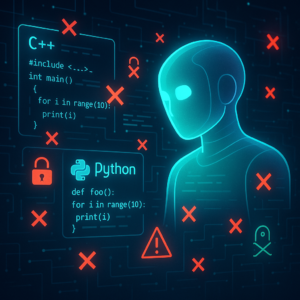Unleashing AI’s Coding Muscle: How Data Science Challenges Test Large Language Models

Unleashing AI’s Coding Muscle: How Data Science Challenges Test Large Language Models
When it comes to solving complex problems faster and more efficiently, technology is our trusty sidekick. Most recently, large language models (LLMs) have been stepping into the spotlight in the world of data science. These AI-powered wizards are showing promise in automating tasks that usually take data scientists ages to finish. Today, we’re diving into the world of LLMs and their potential to revolutionize data science code generation through a fresh look at a study called “LLM4DS.”
What’s the Fuss About Language Models in Data Science?
Think about how much time and brainpower it takes for data scientists to clean data, run analyses, and create stunning visualizations. For years, these tasks have demanded intense coding skills and patience. However, what if AI could take a chunk of that responsibility off human hands? Enter: Large Language Models. These AI tools are more than just fancy text generators—they could actually create functional, efficient code for various data science problems.
The research carried out by Nathalia Nascimento and her team decided to put these LLMs to the test. Specifically, they wanted to find out how well Microsoft’s Copilot, ChatGPT, Claude, and Perplexity Labs’ models stacked up against real data science coding challenges. Could they deliver code that works as intended, or are they just flashy pretenders?
Breaking the Ice: How LLMs Were Tested
The researchers conducted a pretty intense experiment. Picture this: they selected 100 diverse problems from the Stratacratch platform, which is like a playground filled with data science-colored puzzles. These problems ranged across difficulty levels (easy, medium, hard) and categories (analytical, algorithm, and visualization). Using a careful methodology called the Goal-Question-Metric (GQM) approach, the team assessed how accurately and efficiently each LLM could spit out correct code.
Here’s a simple analogy: imagine you’ve tasked different AI chefs to make you recipes (code) from scratch based on different instructions (prompts). The test is to see which chef whips up a dish that’s not only edible but delicious (correct and efficient code) in the shortest time possible.
The Results Are In: How Did They Do?
The good news? All models performed above a 50% baseline success rate, meaning they were doing better than, say, a rookie programmer trying to guess their way through the code. But here comes the nitty-gritty:
- ChatGPT and Claude outshone their peers, surpassing a 60% success rate.
- However, not one of the models hit a perfect 70% mark, highlighting room for improvement.
Intriguingly, ChatGPT is somewhat of an all-rounder, proving to be consistent across various problem complexities. Meanwhile, while Claude seemed to falter with increasingly tough challenges, ChatGPT remained steadfast.
Breaking Down the Numbers: Success, Speed, and Quality
Success Rate: More than Just Correctness
Success wasn’t just about getting the right number; it was also about doing it efficiently and with quality. Each model had up to three shots to get it right for each problem, which led to noticeable differences: – Across all difficulties, ChatGPT led with a solid performance in analytical and algorithmic challenges. – Interestingly, no model consistently excelled in visualization tasks, though ChatGPT showed the most accurate outputs there.
Speed and Execution: Not All Heroes Are Fast
When it comes to how quickly these models could churn out solutions, Claude topped the charts with the fastest execution times. ChatGPT, on the other hand, was a bit of a slow poke in this area, which might be something to consider if speed is a critical factor for you.
Quality and Consistency: The Deeper Measures
Quality of code wasn’t just judged on whether it worked but how closely it matched the expected solution, especially for visual outputs. Surprisingly, despite speed bumps, ChatGPT often produced better quality in creating visuals, perhaps making it a better choice when accuracy is prioritized over time.
Implications for the Real World
So, when and where might you deploy these AI assistants? If you’re a data scientist with a workload calling for quick analysis and understandable results, both ChatGPT and Claude could enhance your productivity, albeit with ChatGPT having an edge in dealing with tougher problems.
For those invested in visualization tasks, while ChatGPT shows more promise, each model’s ability across different task types shows potential. However, performance consistency remains a bottleneck, suggesting that there’s still a journey ahead for these models in truly mastering the intricacies of data science.
Key Takeaways
-
LLMs as Coders: All the large language models evaluated can generate more than half of their coding tasks correctly, moving beyond mere chance.
-
Top Performers: ChatGPT and Claude stood out, with ChatGPT demonstrating strong versatility across task complexities.
-
Room for Improvement: No model consistently reached the 70% success rate, signaling ongoing limitations in challenging tasks.
-
Real-World Application: ChatGPT shows promise in complex and analytical scenarios, while Claude is commendable for tasks needing swift implementation.
-
Quality vs. Speed: For those prioritizing high-quality visual outputs, ChatGPT shines, though it may take longer.
This deep dive into the capabilities of LLMs unveils not only their burgeoning potential but also highlights the current boundaries they face. Whether these AI tools are the next big thing in automating code generation remains up for debate, but there’s no doubt they’re heading in an intriguing direction—one that could alleviate some of the time-intensive burdens of data science. If you’re considering leveraging AI in your data tasks, understanding these strengths and weaknesses is the first step to optimizing your workflow and enhancing productivity.
If you are looking to improve your prompting skills and haven’t already, check out our free Advanced Prompt Engineering course.
This blog post is based on the research article “LLM4DS: Evaluating Large Language Models for Data Science Code Generation” by Authors: Nathalia Nascimento, Everton Guimaraes, Sai Sanjna Chintakunta, Santhosh Anitha Boominathan. You can find the original article here.




